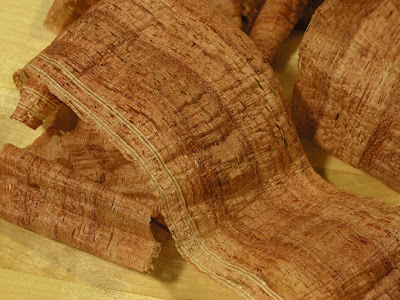I save most of my off cuts in two groups; Big scrap and small scrap. The bigger stuff I try and reuse to make other parts, the smaller stuff works well for cauls, push sticks, patches etc.
The back patch was made from an offcut from the bottom segment of the heel stack. I was a very nice piece of quatersawn mahogany about 3"x4"1/2", and as it already had one nicely planed flat face, it only needed little preparation to be made in to two back patches.
I started off by truing the sides and edges on the shooting board. Then the rough face was cleaned up and thickness to 10mm, cut into four 7/8" wide segments and glued together into one 12" long cross grained stick.
After the glue had set overnight, I ran the stick trough my bandsaw twice, but before the second cut I planed off all the saw marks on the stock. This gave me three 1/8" thick segments, planed on one side and rough on the other. In the end the three segments were glued into one 36" long graft. The back graft for this build only needed to be about 14-15" long which left me a spare one ready for my next build - in 2053...
I used double sided stickytape to secure the thin graft on the bench for the final planing. I started off without, but quickly learned the danger in this, as the thin and fragile graft broke from bending upwards once the plane bit into it. One would have thought I would have learned my lesson from planing the sides, but apparently not.
Last, the two grafts were jointed to final width. The one for this build was planed down to 20mm, whereas the other one was left at full width.
I started off by truing the sides and edges on the shooting board. Then the rough face was cleaned up and thickness to 10mm, cut into four 7/8" wide segments and glued together into one 12" long cross grained stick.
After the glue had set overnight, I ran the stick trough my bandsaw twice, but before the second cut I planed off all the saw marks on the stock. This gave me three 1/8" thick segments, planed on one side and rough on the other. In the end the three segments were glued into one 36" long graft. The back graft for this build only needed to be about 14-15" long which left me a spare one ready for my next build - in 2053...
I used double sided stickytape to secure the thin graft on the bench for the final planing. I started off without, but quickly learned the danger in this, as the thin and fragile graft broke from bending upwards once the plane bit into it. One would have thought I would have learned my lesson from planing the sides, but apparently not.
Last, the two grafts were jointed to final width. The one for this build was planed down to 20mm, whereas the other one was left at full width.





































